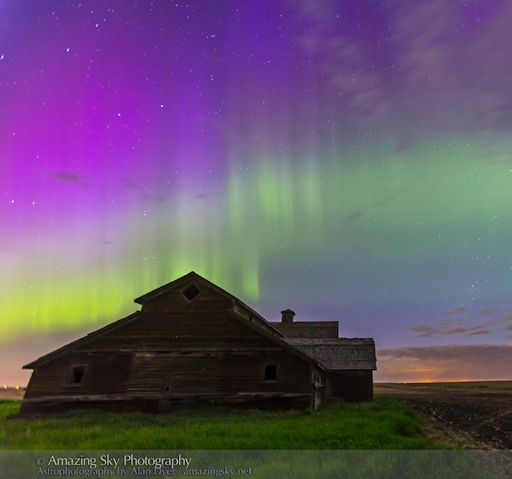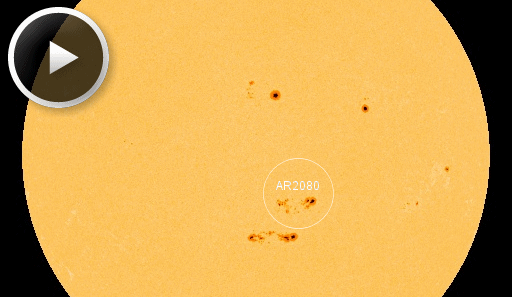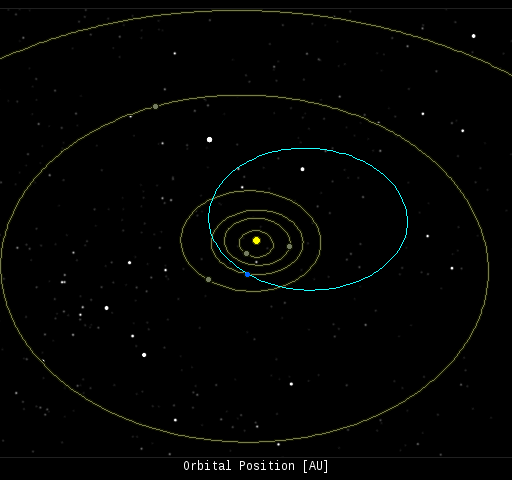When is the best time to see auroras? Where is the best place to go? And how do you photograph them? These questions and more are answered in a new book, Northern Lights - a Guide, by Pal Brekke & Fredrik Broms. | | | FATHER'S DAY AT THE EDGE OF SPACE: Would you like to send your dad to the Edge of Space? He can't go, but his picture can. Using a suborbital helium balloon, the students of Earth to Sky Calculus will fly the image of your choice to 120,000 ft and photograph it against the curved limb of the Earth. The returned photo (example) makes a great Father's Day gift. The flight fee is $49.95, and profits support student research. Contact Dr. Tony Phillips for details. PURPLE AURORAS: Over the weekend, the sky above Canada and many northern-tier US states turned purple. It was the aurora borealis, sparked by a CME impact during the late hours of June 7th. "Wonderful purple and blue auroras spanned the sky, peaking between 2 and 2:30 a.m. MDT on June 8th," reports Alan Dyer, who captured the colors outside an old barn in Alberta, Canada: 
In auroras, purple is a sign of nitrogen. While oxygen atoms produce the green glow in Dyer's image, the purple comes from molecular nitrogen ions at very high altitudes. For some reason, high-altitude nitrogen was unusually excited during this G2-class geomagnetic storm, and many people witnessed its telltale hue. More purple could be in the offing. A solar wind stream following in the wake of the CME has kept Earth's magnetic field unsettled two full days after the CME's impact. Solar wind speeds are now greater than 500 km/s, prompting NOAA forecasters to boost the odds of a polar geomagnetic storm on June 9th to 50%. Aurora alerts: text, voice Realtime Aurora Photo Gallery WAITING FOR AN X-FLARE: Sunspot AR2080 s now squarely-facing Earth, an arrengement which could lead to a geoeffective X-flare. The sunspot has a 'beta-gamma-delta' magnetic field that harbors energy for strong eruptions, and it has been growing rapidly alongside several companion spots. These developments are shown in a three-day movie from NASA's Solar Dynamics Observatory: 
As the sunspots have ballooned in size, they have attracted the attention of sunset photographers. This snapshot, submited by Mila Zinkova of San Francisco CA, shows the sunspots bizarrely distorted by atmospheric refraction beneath a lovely green flash. Now if only one of them would flare.... NOAA forecasters estimate a 35% chance of M-flares and a 15% chance of X-flares on June 9th. Solar flare alerts: text, voice Realtime Space Weather Photo Gallery
Realtime Comet Photo Gallery
Realtime Meteor Photo Gallery
Every night, a network of NASA all-sky cameras scans the skies above the United States for meteoritic fireballs. Automated software maintained by NASA's Meteoroid Environment Office calculates their orbits, velocity, penetration depth in Earth's atmosphere and many other characteristics. Daily results are presented here on Spaceweather.com. On Jun. 9, 2014, the network reported 2 fireballs.
( 2 sporadics)  In this diagram of the inner solar system, all of the fireball orbits intersect at a single point--Earth. The orbits are color-coded by velocity, from slow (red) to fast (blue). [Larger image] [movies]
Potentially Hazardous Asteroids ( PHAs) are space rocks larger than approximately 100m that can come closer to Earth than 0.05 AU. None of the known PHAs is on a collision course with our planet, although astronomers are finding new ones all the time. On June 9, 2014 there were 1485 potentially hazardous asteroids. Notes: LD means "Lunar Distance." 1 LD = 384,401 km, the distance between Earth and the Moon. 1 LD also equals 0.00256 AU. MAG is the visual magnitude of the asteroid on the date of closest approach. | | The official U.S. government space weather bureau | | | The first place to look for information about sundogs, pillars, rainbows and related phenomena. | | | Researchers call it a "Hubble for the sun." SDO is the most advanced solar observatory ever. | | | 3D views of the sun from NASA's Solar and Terrestrial Relations Observatory | | | Realtime and archival images of the Sun from SOHO. | | | from the NOAA Space Environment Center | | | the underlying science of space weather | | 
